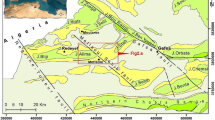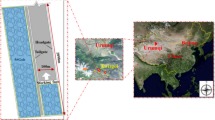Abstract
The paper describes the recent devastating landslide of Kotrupi, Himachal Pradesh in India which had claimed many human lives and properties along its course on 13 August 2017. This event was the third reactivation of the slide as per data available. The study for this landslide involves a preliminary investigation of the site and comparison of pre- and post-event slope stability analysis. Other than rainfall, the combined effect of differential weathering rate of the debris and soil layers, low material strength, and the presence of a fault zone was found to be the primary cause of instability. The analysis was carried out with the geotechnical investigation and numerical modeling with the help of finite element model-based Phase 2 simulator. The significant findings of this paper include numerical simulation of pre- and post-event slide as stated under unsaturated and saturated condition. The study finds a low factor of safety of the present slope. The unstable condition of the slope may trigger another event of the same intensity shortly.









Similar content being viewed by others
References
Bhakuni SS, Philip G, Suresh N (2017) Structural analysis of Nalagarh lobe, NW Himalaya: implication of thrusting across tectonic edge of NW limb of Nahan salient, Himachal Pradesh, India. Int J Earth Sci 106:1773–1795. https://doi.org/10.1007/s00531-016-1385-1
Bru G, Herrera G, Fernández J (2018) Site scale modeling of slow-moving landslides, a 3D viscoplastic finite element modeling approach. Landslides 15(2):257–272. https://doi.org/10.1007/s10346-017-0867-y
Chand J (2014) Mechanism of landslides of National Highway- 22 in Himachal Pradesh. International Referred Online Research Journal 20:8–19
Chandel VBS (2016) Geo-physical disasters in Himachal Pradesh: a spatial perspective. Int J Multidiscip Approach Stud 2(5):82–89
Eberhardt E (2003) Rock slope stability analysis - utilization of advance numerical techniques. Lecture notes in Earth and Ocean Sciences at UBC (pp 1–41)
Farshidfar N, Nayeri A (2015) Slope stability analysis by shear strength reduction method. J Civ Eng Urban 5:35–37
Hammah RE, Yacoub T, Corkum B, Wibowo F, Curran JH (2007) Analysis of blocky rock slopes with finite element shear strength reduction analysis. Vancouver, Canada: 1st Canada-U.S. Rock Mechanics Symp. 329-334. https://doi.org/10.1201/NOE0415444019-c40
Jamir I, Gupta V, Kumar V, Thong GT (2017) Evaluation of potential surface instability using finite element method in Kharsali Village, Yamuna Valley, northwest Himalaya. J Mt Sci 14:1666–1676. https://doi.org/10.1007/s11629-017-4410-3
J Jing L, Hudson JA (2002) Numerical methods in rock mechanics. Int J Rock Mech Min Sci 39:409–427. https://doi.org/10.1016/S1365-1609(02)00065-5
Lenka SK, Panda SD, Kanungo DP, Anbalagan (2017) Slope Mass Assessment of Road Cut Rock Slopes Along Karnprayag to Narainbagarh Highway in Garhwal Himalayas, India. In: RMikoš M, Vilímek V, Yin Y, Sassa K (eds) Advancing Culture of Living with Landslides. Vol. 5, Landslides in Different Environments, pp. 407-413. Ljubljana, Slovenia: 4th World Landslide Forum. https://doi.org/10.1007/978-3-319-53483-1
Pradhan SP, Vishal V, Singh TN (2018) Finite element modelling of landslide prone slopes around Rudraprayag and Agastyamuni in Uttarakhand Himalayan terrain. Nat Hazards 94:181–200. https://doi.org/10.1007/s11069-018-3381-1
Scaringi G, Fan X, Xu Q, Liu C, Ouyang C, Domènech G, Yang F, Dai L (2018) Some considerations on the use of numerical methods to simulate past landslides and possible new failures: the case of the recent Xinmo landslide (Sichuan, China). Landslides 15:1359–1375. https://doi.org/10.1007/s10346-018-0953-9
Siddque T, Pradhan SP (2018) Stability and sensitivity analysis of Himalayan road cut debris slopes: an investigation along NH-58, India. Nat Hazards 93:577–600. https://doi.org/10.1007/s11069-018-3317-9
Siddique T, Pradhan SP, Vishal V, Mondal MEA, Singh TN (2017) Stability assessment of Himalayan road cut slopes along National Highway 58, India. Environ Earth Sci 76:759. https://doi.org/10.1007/s12665-017-7091-x
Stead D, Eberhardt E, Coggan J, Benko B (2001) Advanced numerical techniques in rock slope stability analysis – applications and limitations, in Proceedings of International Conference on Landslides–Causes, Impacts and Countermeasures, pp 615–624, Davos, Switzerland, June 2001
You G, Mandalawi MA, Soliman A, Dowling K, Dahlhaus P (2018) Finite Element Analysis of Rock Slope Stability Using Shear Strength Reduction Method. In: Frikha W., Varaksin S., Viana da Fonseca A. (eds) Soil Testing, Soil Stability and Ground Improvement. GeoMEast 2017. Sustainable Civil Infrastructures. Springer, Cham. https://doi.org/10.1007/978-3-319-61902-6_18
Zhao ZSL, Li L, Zhang Y (2018) Distinct element modelling of a landslide triggered by the 5. 12 Wenchuan earthquake: a case study. Geotech Geol Eng 36:2533–2551. https://doi.org/10.1007/s10706-018-0481-3
Zheng Y, Tang X, Zhao S, Deng C, Lei W (2009) Strength reduction and step-loading finite element approaches in geotechnical engineering. J Rock Mech Geotech Eng 1:21–30. https://doi.org/10.3724/SP.J.1235.2009.00021
Author information
Authors and Affiliations
Corresponding author
Rights and permissions
About this article
Cite this article
Pradhan, S.P., Panda, S.D., Roul, A.R. et al. Insights into the recent Kotropi landslide of August 2017, India: a geological investigation and slope stability analysis. Landslides 16, 1529–1537 (2019). https://doi.org/10.1007/s10346-019-01186-8
Received:
Accepted:
Published:
Issue Date:
DOI: https://doi.org/10.1007/s10346-019-01186-8




